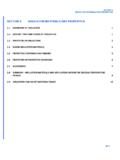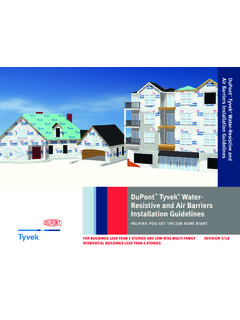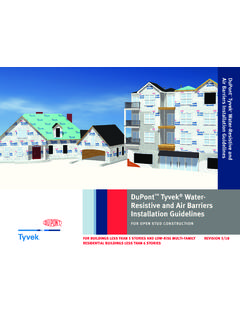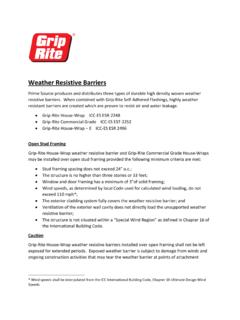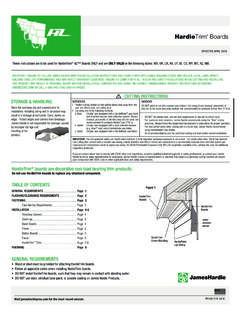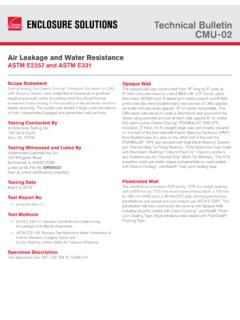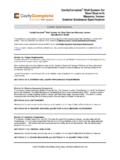Transcription of OVERVIEW: FIRESTOPPING, SMOKE SEALS AND AIR …
1 SECTION 9. firestopping , SMOKE SEALS AND AIR barriers . SECTION 9: firestopping , SMOKE SEALS AND AIR barriers . overview : firestopping , SMOKE SEALS AND AIR barriers 1. MATERIALS 2. FS-0. SECTION 9. firestopping , SMOKE SEALS AND AIR barriers . SECTION 9. firestopping , SMOKE SEALS AND AIR barriers . overview : firestopping AND SMOKE SEALS . It is critical that the compartmentalization of a structure -- created by the use of fire rated floor, wall and ceiling assemblies -- be maintained in order to reduce the severity of a fire and the passage of developing SMOKE and gases to ensure safety to both life and property. When penetrations are created for building services, within a fire rated floor, wall or roof assembly it becomes critical to seal these penetrations to a rating equivalent to the fire resistance rating of the assembly.
2 This design approach will assist in confining a fire to its origin, thereby giving the building's suppression system of firefighters a better chance to control it before the entire structure becomes involved. The Standards Council of Canada has adopted criteria for minimum test procedures and performance standards resulting in acceptable test methods and standards in Canada. The acceptable test method in Canada is CAN/ULC- S101-04 ("Standard Methods of Fire Endurance Tests of Building Construction and Materials"). The acceptable test standard in Canada is ULC-S115-1995(R2001) "Fire Tests of Firestop Systems". Both have been included into the National Building Code. Only testing agencies with Standards Council of Canada (SCC) accreditation are considered acceptable testing laboratories.
3 In Canada, building codes address this issue. National Building Code of Canada (NBC) - Building Services in Fire Separations and Fire Rated Assemblies - Fire Stopping of Service Penetrations. These subsections specify requirements for the use of "tested" fire stop materials for sealing building services which penetrate a fire separation or an assembly required to have a fire resistance rating. Service penetration assemblies are assigned a fire rating when tested in accordance with the Fire Tests of Firestop Systems, ULC-S115. These firestop assemblies are intended for use in openings in fire resistive wall and/or floor assemblies which are evaluated in accordance with CAN/ULC-S101. Under ULC-S115, ratings may be established for each firestop assembly (F, FT, FH and FTH).
4 An "F" rating is based upon flame occurrence on the unexposed surface. An "FT" rating is based upon temperature rise criteria as well as flame occurrence on the unexposed surface. When a test sample is also subjected to a hose stream test, "FH" and "FTH" ratings may be established. An "FH" rating is based upon flame occurrence on the unexposed surface and acceptable performance during the hose stream test. An "FTH" rating is based upon a temperature rise criterion, flame occurrence on the unexposed surface and acceptable performance during the hose stream test. The rating of a firestop system applies to its use in the specific assembly of materials, penetrations, annular spaces and floor or walls in which it was tested.
5 Under building code requirements where piping or ductwork penetrates a fire rated wall or floor assembly, the joint between the fire assembly construction and piping or ducts must be sealed with a fire tested and rated firestopping and SMOKE seal materials to prevent the passage of SMOKE and flame through such joints. Such firestopping materials shall consist of material that will remain in place and prevent the passage of flame and SMOKE when subjected to the standard fire exposure in CAN/ULC-S101, for a period of time equal to the protection rating required for the grade of fire separation. Under ULC-S115 this is classified as an "F" rating. The ULC-S115 definition of temperature rise ("T" rating) for firestopping materials can be briefly defined as "the unexposed surfaces of firestop materials or penetrating items shall not have a measured temperature rise greater than 180 C for the duration of the hourly time/temperature rating.
6 " firestopping materials conforming to both flame rating ("F" rating) and temperature rating ("FT" rating) under ULC-S115 are classified as having an "FT" rating. FS-1. SECTION 9. firestopping , SMOKE SEALS AND AIR barriers . A firestopping system should not only conform to the relevant flame rating, but equally important it should have a hose stream test rating ("H" rating) to prevent passage of gases or water. In some instances a temperature rise ("T". rating) may be required to prevent the ignition of highly combustible materials which may be stored within close proximity to the unexposed side of the firestopping . In order to provide a specifier with accurate and concise specifications which conform to building code requirements, a suggested single source specification for firestopping and SMOKE SEALS has been developed for TIAC for incorporation by a specifying authority in the project specifications.
7 It is recommended that this single source specification be incorporated in the project specifications under a separate section under Section [07840] [07 84 00] (Refer to Section 15 of this manual for a master specification). overview : AIR barriers . An air barrier is required by the building code as a requirement to contain an interior controlled environment. Refer to an Air Barrier definition in the Glossary in Section 17. Air barriers are different than vapour retarders in that an air barrier is to stop air infiltration or exfiltration whereas a vapour retarder is to slow down or arrest moisture movement through building enclosure materials. At any location in the building's enclosure, an air barrier seal is subjected to a variety of pressures and suction.
8 The point at which these imposed loads on an air barrier are at their highest level, is usually at the upper-most part of the enclosure during the winter and at the lower-most part in the summer. Most vapour retarder materials will not contain those pressures therefore an air barrier seal is required. There are occasions where piping, conduit or ducting penetrates the contained building envelope. Those components are usually insulated and wrapped or covered, up to the point of a penetration. At that juncture, the component must be air sealed in conjunction with the building's air barrier seal . The objective is to eliminate air leakage in either direction. Air barrier criteria and requirements are usually specified is a specification section located in MasterFormat Division 08.
9 If a fire stop is required to seal a roof assembly penetration (perhaps a rated roof assembly) by pipe, conduit, or a duct, then a specifier will usually specify a firestopping seal material that will also function as an air barrier seal . That material or product may appear in a Division 07 section (within an Air Barrier section) or in a Division 08. (Sealant) section. MATERIALS. The following list contains manufacturer's firestopping and SMOKE seal materials in regular supply which have been fire tested and rated as required by the building code. These materials are listed for information only and their suitability for the intended application and the acceptability by local authorities having jurisdiction should be confirmed by a specifying authority.
10 In addition, the prices for such firestopping materials vary by manufacturer and such prices should be checked with the manufacturer or the distributor by a specifier. All firestopping materials proposed to be used must conform to ULC-S115 and CAN/ULC-S101. The acceptability of ULI (USA) or by ULC by local authorities having jurisdiction, should be confirmed by the Contractor to ensure that the test procedures were performed to ULC-S115 and CAN/ULC-S101. - Dow Corning Corporation - Tremco Ltd. - Firestop Systems Inc. - General Electric Canada Inc. The materials used in firestop assemblies must be the exact material tested and listed by the certifying agency and bear that agency's certification mark ( Warnock Hersey or ULC).
